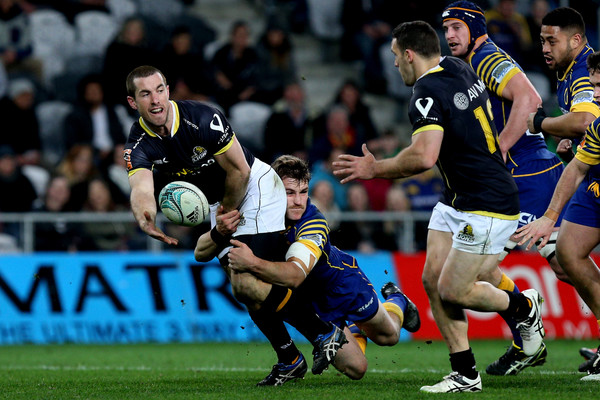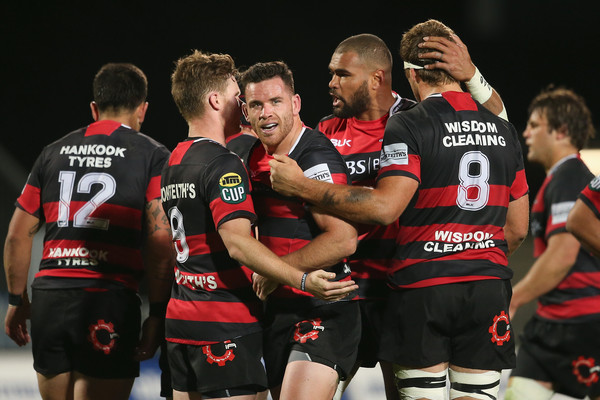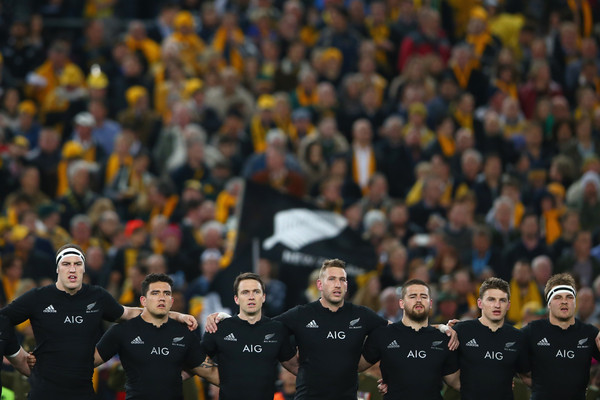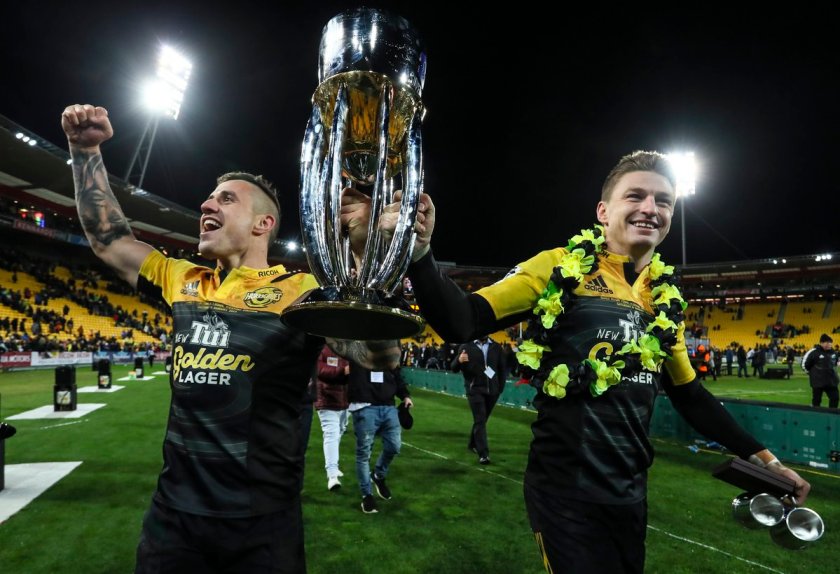
On Saturday, 6th of August, 2016 at Westpac Stadium, Wellington, the 2016 Super Rugby final was contested between the Hurricanes from Wellington and the Lions from Johannesburg. The two franchises had never won the Super Rugby competition before.
That final was always going to be spectacular as the two franchises which were facing each other had very good attacking records in the competition with a big amount of tries scored. It was also an opportunity to witness the depth that New Zealand and South Africa have.
Following the end of the regular season, the Hurricanes finished at the top of the New Zealand conference and at the top of the Super Rugby table. They won their Quarter-Finals and their Semi-Finals at home which was explaining their home advantage for the final.
It was the third Super Rugby final for the Hurricanes and the second final in two seasons. Last season was a disappointment for the fans as the Wellington-based franchise could not get the Trophy after the 2015 final with the Highlanders claiming the win and Glory.
So, that was another opportunity for the Hurricanes to finally win the Super Rugby and reward the incredible work which has been done for this franchise since 1996. To reach that goal, they had to win that final home game against the Lions, the south-african side.
Team News : Trusting all the squad, all the players
During all the week, in the build-up to the final, the Hurricanes training camp was very relaxed and did not want to feel the pressure of the final. The fact is that most of the starting XV playing this season played the 2015 final and they wanted to learn from that.
Leader and playmaker Beauden Barrett revealed that beating that disappointment of the 2015 season by reaching the final again and finally winning it was the big motivational factor not only for him but for the squad and the players who knew this disappointment.
The Hurricanes coaching staff, coach Chris Boyd and assistant coach John Plumtree, worked hard to build a strong gameplan. Chris Boyd made the overall analysis of the Lions playing abilities while John Plumtree focused on getting the defence right for the game.
During the starting XV’s announcement made on Thursday by Chris Boyd, three players were a doubt for the final. Hooker Dane Coles, prop Reggie Goodes and back-rower Callum Gibbins were respectively bracketed with Ricky Riccitelli, Mike Kainga and Tony Lamborn.
Finally, there were absolutely no surprise in the starting XV which was named by Chris Boyd. Hooker and skipper Dane Coles managed to recover from his rib injury to get a starting position. Loni Uhila and Ben May, the two powerful props, retained their jerseys.
In the second-row, future legend Vaea Fifita and Michael Fatialofa returned in this successful partnership. Victor Vito was named at number 8 and will make a strong back-row with the flankers Ardie Savea and Brad Shields, very powerful in the breakdown area.
With the backline, it remained a classic with TJ Perenara and Beauden Barrett leading the team from the half-backs positions. In the centres, the same combination was trusted with Willis Halaholo at number 12 and Matt Proctor at number 13 starting in the midfield.
Coach Chris Boyd made the same calls in the back-three with Jason Woodward and Cory Jane taking the two wings. Finally, James Marshall took the fullback position with this ability to run the ball and being the second playmaking option along with Beauden Barrett.
On the bench, there was cover in all the positions. Ricky Riccitelli with Chris Eves and Mike Kainga covered the front-row. For the second-row and the back-row, there was room on the bench for Mark Abbott and Callum Gibbins, replacing the flanker Tony Lamborn.
Exactly three backs started the game on the bench with Jamison Gibson-Park, the scrum-half. Vince Aso was there to cover the centre and played well during all season. Struggling in this 2016 Super Rugby season, winger Julian Savea started the big final on the bench.
First-half : Classic weather conditions in Wellington
The 2016 Super Rugby final was referred by the New Zealander Glen Jackson. The first-half started in terrible weather conditions with rain and wind. The Lions won the toss and took the kick-off to play against the wind in the first-half to be more comfortable afterwards.
Promising Springboks fly-half Elton Jantjies kicked off and the first-half was underway in front of the 36,500 fans of the Westpac Stadium. Misjudging the conditions, the ball had to much power, went over the Hurricanes try line so it was scrum on the halfway line quickly.
Securing the ball at scrum time with the help of back-rower Victor Vito, playing his 100th game for the franchise, the Hurricanes scrum-half TJ Perenara decided to throw the ball wide but the pass was inaccurate and winger Cory Jane could not catch it on the left wing.
Under the rain, the Lions had the first lineout of the game with hooker Malcolm Marx finding his jumper Franco Mostert for a driving maul. The Hurricanes defended well in a first time with the props Loni Uhila and Ben May trying to stop the Lions’ forwards pack.
Referee Glen Jackson penalised the second-rower Vaea Fifita for an off-side position. That was a first opportunity for the Lions playmaker Elton Jantjies. Taking the penalty, from 40 metres out, Elton Jantjies did not have the power and the Hurricanes got that ball (0-0).
Taking it in his 22-metre zone, fullback James Marshall made the clearing kick. The Lions back-three picked the ball with Ruan Combrinck making an up-and-under. However, the ball was gathered by the Hurricanes first-five eighth Beauden Barrett who kicked as well.
He found a touch on the Lions 22-metre line with Malcolm Marx making the throw. The Hurricanes managed to win the ball back and following good linespeed from TJ Perenara and Willis Halaholo, Beauden Barrett made a crossed-field kick for his winger Cory Jane.
Former All Blacks legend found the space and scored the try but Glen Jackson was called by the TMO (Television Official Official) for a potential knock-on. After review, Ben Skeen confirmed that flanker Brad Shields made the handling error in the build-up of the try.
Glen Jackson ruled the try out and the Lions had the feed at scrum on their 22-metre line. Presenting the ball at scrum, Faf de Klerk wanted the quick ball but the Lions got the penalty thanks to the efforts from the two big props Dylan Smith and Julian Redelinghuys.
Under pressure, the Hurricanes did not have much possession but stole the ball once again in the lineout thanks to lock Michael Fatialofa. The Hurricanes players started their real first build-up with good phases of play. Centre Matt Proctor looked for space in defence.
Relying much on their forwards’ power, with the carries from Dane Coles and Ardie Savea, the Wellington-based franchise got a penalty near the Lions’ 22-metre zone. On the right of the posts, Beauden Barrett made no mistake to take the lead after 12 minutes (3-0).
The Springboks fly-half Elton Jantjies made the re-start but the Hurricanes back-three made no mistake with Jason Woodward providing some belief to the team from his wing. Chris Boyd’s men were looking to release the pressure with the Lions showing passion.
With the weather conditions still awful, the management started to be the gameplan for the two franchises. Johan Ackermann, the Lions coach, gave instructions to his players to make the pressure kicks to try and win the ball back at the breakdown in that midfield.
Scrum-half Faf de Klerk started to add pace in his game. Flankers Jaco Kriel and Warwick Tecklenburg gained valuable metres with fullback Andries Coetzee often coming at centre to provide strong runs. The Hurricanes hold on in defence with Victor Vito making calls.
Rohan Jansé Van Rensburg, playing centre for the Lions, tried some offloads in the midfield but his opposite number Willis Halaholo read well the combinations. The Lions were often looking for their winger Courtnall Skosan, bringing a very big attacking threat.
Playing the 20th minute, the Hurricanes were still under the Lions’ pressure. Fullback Andries Coetzee kicked an up-and-under which was taken by Cory Jane. Receiving the ball from a teammate, the Hurricanes playmaker Beauden Barrett made a great territorial kick.
Back in their own half, hooker Malcolm Marx got the information from his skipper Warren Whiteley about the combination. The second-rower Andries Ferreira took the ball and the franchise from South Africa started a build-up in their 22-metre zone with loose passes.
In front of a very organised Hurricanes’ defence, Elton Jantjies threw the ball to his centre Lionel Mapoe. The Lions centre attempted a grubber which was taken in the air by winger Cory Jane who handled the pressure at the tackle from Andries Ferreira to score (8-0).
With 25 minutes played in the final, Beauden Barrett had a tough conversion, completely on the right touchline. Keeping his routine, the All Blacks players outstandingly converted the try and the Hurricanes were taking the 10-point lead in this Super Rugby final (10-0).
The Lions had to react quickly and they managed to do that. From the re-start, the Hurricanes did not hang to the ball. The Lions carried the ball with Ruan Combrinck and flanker Jaco Kriel. They were awarded penalty following an Hurricanes’ off-side position.
Skipper Warren Whiteley opted to take the penalty and from 20 metres out, just in front of the post, playmaker Elton Jantjies scored the first Lions points in the final (10-3). With less than a quarter to go in the first-half, the Hurricanes had to win the possession back.
Nevertheless, that was a huge ask as the Hurricanes were penalised once again for not releasing the ball with Brad Shields, not getting enough support at the breakdown. That was another penalty for the Lions who were targeting the Hurricanes’ lineout in the game.
Malcolm Marx connected with his jumpers and Johan Ackermann’s players were bringing the big intensity to this Super Rugby final. Hard on defence, Vaea Fifita made the huge tackles with the prop Loni Uhila contesting the breakdown with the number 8 Vicor Vito.
Forcing the Lions’ handling errors, centre Rohan Jansé Van Rensburg knocked the ball on. The Hurricanes had the scrum and kicked the ball away thanks to Beauden Barrett. The Lions counter attacked with Andries Coetzee kicking a lot and Courtnall Skosan waiting.
Having the lineout, skipper Dane Coles made the throw and TJ Perenara made the pass to Beauden Barrett. Making the crossed-field kick, it was charged down and the Hurricanes fullback James Marshall covered the ball. The Lions’ pack rushed and won a great scrum.
Winning the 5-metre scrum following an unplayable ball at the breakdown, the Lions added even more pressure when Ardie Savea was caught off-side at scrum time with the 35th minute being played. Skipper Warren Whiteley wanted try and asked for new scrum.
Embracing the battle, Loni Uhila and Ben May made a huge statement at scrum and earned the penalty with Dylan Smith penalised for standing up. The Hurricanes released the pressure and played on the Lions’ half with the half-time coming soon in Wellington.
After a lineout won in their 22-metre zone, scrum-half Faf de Klerk kicked the ball into touch and the Hurricanes were leading by a converted try at half-time (10-3). Cory Jane scored the only try so far in this final with the Lions getting the most of the possession.
Second-half : Ruthless and Clinical from the Hurricanes
That second-half was played in the same conditions than the first-half. There was still some strong rain and wind and the Hurricanes adapted better to the conditions as they are used to play in this Westpac Stadium while the Lions are not too familiar with that, in fact.
First-five eighth Beauden Barrett kicked off and the second-half was starting with the Lions looking to launch the fightback with Faf de Klerk and Elton Jantjies making some clever combinations to gain metres and release the pressure from their own half, there.
Only a couple of minutes in this second-half and the Hurricanes players were back in their 22-metre zone, trying to build their usual game thanks to good carries from the forwards pack and then unleashing the backline and create these gap for the world-class finishers.
Winger Jason Woodward and fullback James Marshall tried to combine on that left wing but there was a knock-on which was made so the Lions had an early opportunity to score and come back into this game. The two franchises were playing for 4 minutes in this half.
The Hurricanes skipper and hooker Dane Coles stayed down in the last phases of play and seemed to have injured his rib cartilage again. He was replaced by Ricky Riccitelli who had to do the job immediately with that Lions attacking scrum on the Hurricanes’ half, there.
Making the same impact than in the last scrums of the first-half, the two Hurricanes props Loni Uhila and Ben May drove the pack forward and scrum-half TJ Perenara put his hands on the ball. Unfortunately, it was another handling error which was so frustrating.
Referee Glen Jackson awarded a scrum to the Lions and the game started to lose a bit of momentum as a lot of scrums were contested in the beginning of the second-half. The playmakers from the two franchises just chose to keep kicking to win the territory game.
It was even more curious to witness the Lions going for these tactics because they were chasing the score. Fullback Andries Coetzee tried to be more accurate with his garryowens with winger Ruan Combrinck chasing and Jaco Kriel directing the attack and the defence.
Playing a little bit more in the Lions’ half, the Hurricanes backline was waiting the best moment to launch the attacking combinations. The forwards pack was making some pick-and-go but the ball was lost and the Lions had a promising platform at scrum to build try.
Hooker Malcolm Marx leading the scrummagers, the Lions won a new penalty at scrum time after that the Hurricanes front-row collapsed. Elton Jantjies kicked for touch and the Lions had a lineout near the halfway line with Andries Ferreira and Franco Mostert ready.
Ball was gathered by the Lions and some phases of play later, they were back on the Hurricanes’ 10-metre line. Elton Jantjies decided to go back inside for his centre Rohan Jansé Van Rensburg but the Hurricanes defence was solid with Vaea Fifita outstanding.
The Lions raced forwards and rushed again and again in the Hurricanes defence as their playmaker Beauden Barrett just wanted to give his forwards some time to re-organise. The franchise from Johannesburg started a new build-up and the Hurricanes were hanging on.
While they were building nicely with a 10+ phases sequence, Julian Redelinghuys and Warwick Tecklenburg made themselves available. New phases of play were created when the Hurricanes flanker Ardie Savea dove onto the ball, keeping feet to make the turnover.
It was the 50th minute mark and the All Blacks first-five eighth Beauden Barrett found a lineout in the Lions’half. Ricky Riccitelli threw the ball at the lineout but lost the ball. Scrum-half Faf de Klerk got it back and made pressure kick with Courtnall Skosan chasing.
Sure under the high ball, Beauden Barrett returned the favour with Cory Jane winning his duel with Lionel Mapoe. The Lions centre knocked the ball on and it was gathered by lock Andries Ferreira on his 10-metre line in an off-side position. That was a penalty conceded.
Dane Coles having been replaced, TJ Perenara assumed the captain duties and wanted to take the penalty. Near the right touchline and after the 10-metre line, playmaker Beauden Barrett delivered to extend the Hurricanes lead to 10 points with 53 minutes played (13-3).
Elton Jantjies made the quick re-start and fullback James Marshall made the clearance. The Lions needed a score as quickly as possible to get some momentum back. However, the Lions were not comfortable with the conditions and the Hurricanes got another scrum.
Having received a knock, official Glen Jackson asked Ricky Riccitelli to come off for a blood bin. Dane Coles came back on the field but could not prevent the Hurricanes from being penalised at scrum time. The big effort from the skipper probably aggravated the injury.
There was 20 minutes left in this game and the Hurricanes could not hang on to the ball. That was a frustrating night because they did not get the ball much often and when they got it, they were unable to keep it enough longer to let the backline show their talents.
Flanker Brad Shields did not release the ball after good contest from Warren Whiteley. Leader Faf de Klerk organised his forwards while Ricky Riccitelli was back on the field. It paid when the Hurricanes were caught off-side, giving an opportunity to their opponents.
Skipper Warren Whiteley wondered if he was going for the penalty or the lineout. Finally, he decided to go for the penalty and Elton Jantjies lined up for a kick on the left of the posts, 35 metres out. His attempt was wide to the left with 64 minutes in the game (13-3).
The Hurricanes first-five eighth Beauden Barrett made the 22-metre drop-out and that was an exchange of kicks between him and Andries Coetzee. Making a little chip, Beauden Barrett read the plot, took the ball very well but was tackled in the air by a Lions player.
Warren Whiteley escaped a yellow card and Beauden Barrett set up a lineout in the Lions’ 22-metre zone. Ricky Riccitelli tried to combine with Michael Fatialofa but Franco Mostert got the ball but it was not gathered by Ross Cronje, coming at scrum-half for Faf de Klerk.
In some confusion, cover at hooker Ricky Riccitelli kicked in the ball which went over the Lions tryline. Reading the game, Beauden Barrett dove over the Lions whitewash and put pressure onto the ball. Glen Jackson called the TMO for the second time in this 2016 final.
Following the TMO review, Glen Jackson awarded the try to Beauden Barrett (18-3). On the right of the posts, in a similar position to his first penalty in the first-half, the playmaker gave the Hurricanes a comfortable margin and it was the 70th-minute mark now (20-3).
There was some desperation from the Lions who gave everything in the last minutes of the game. They rushed in the Hurricanes’ 22-metre zone but the Wellington-based franchise managed to turn the ball over and Beauden Barrett took the gap before kicking ahead.
All the Hurricanes players chased that kick with the Lions giving the ball away. James Marshall went for the drop-goal but he was short and Ruan Combrinck collected the ball and the Lions were back in attack. Then, phases of play were built by the courageous Lions.
The Hurricanes got the ball back before losing it in the last seconds. After a last turnover from Ricky Riccitelli, the Hurricanes had the penalty. Westpac Stadium was in Heaven and the ball was kicked into touch (20-3). The Hurricanes have won the Super Rugby. At last !
The Barrett Review : Contender for the 2016 World Rugby Player of the Year Award
Kicks : 4/4 – For the third time in six weeks, Beauden Barrett made a 100% from the kicking tee (Blues, Crusaders and Lions). He kicked 2 conversions and 2 penalties under rain and wind including a conversion from right touchline. It will give him confidence.
General play : Beauden Barrett made the assist from a crossed-field kick on Cory Jane’s disallowed try. He scored a try in the final, his 9th of the season, had a huge influence and showed that he knew how to manage a game and how to make these very good decisions.
Conclusion : Beauden Barrett is the 2016 Super Rugby top points scorer with 223 points. He won the 2016 Super Rugby Final Man Of The Match Medal and he is at his best. Beauden Barrett deserves to start for the New Zealand team during the next Rugby Championship.
Beauden Barrett, Take a bow ! You, Legend !
Max.










